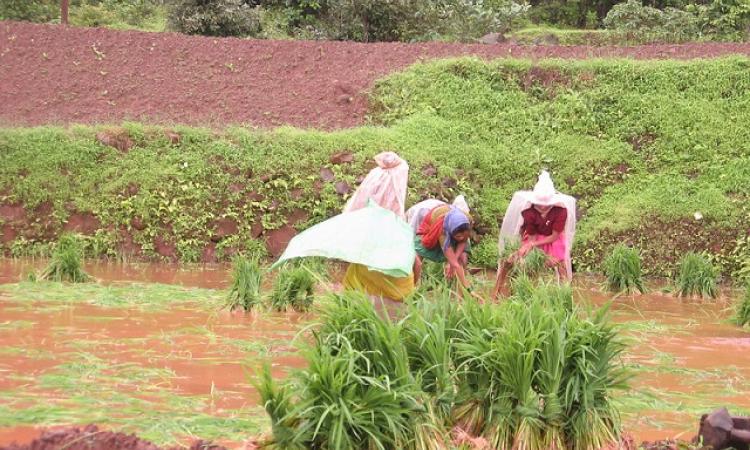
Japanese encephalitis (JE) - a mosquito borne viral disease, is one of the important causes for childhood mortality in Asia. India has a high burden of the disease with 13.7 percent of 63, 854 acute encephalitis cases from 2010 to 2017 caused due to Japanese Encephalitis virus (JEV) leading to deaths in 17 percent of these cases with the north-east being a perennial hotspot for outbreaks.
This paper titled 'High-risk landscapes of Japanese encephalitis virus outbreaks in India converge on wetlands, rain-fed agriculture, wild Ardeidae, and domestic pigs and chickens' published in the International Journal of Epidemiology informs that the Japanese encephalitis virus can be transmitted in animal and human hosts.
Japanese encephalitis (JE) outbreaks in India are generally seasonal and associated with waterlogging and flooding during the monsoons, with stagnant waters being breeding sites for mosquitoes. However, transmission can happen at any time of the year with rural populations being at a high risk, although some urban locations also experience outbreaks.
The infection ecology of JEV is complex and continues to be incompletely understood in India due to which the transmission of the virus is poorly controlled, inspite of the high number of cases in the country.
Birds and animals can serve as hosts for the JE virus
A range of birds and animals such as wading birds, domestic pigs can be the primary reservoirs and maintenance hosts for JEV and many wading birds may also act as amplifying or bridging hosts, and can transmit the virus to humans or pigs, depending on their contact with humans or animals. Some heron species are also found in rice fields and can act as hosts for the virus due to their increased contact with people and domestic animals. Poultry may also act as a bridge that can help in transmitting the virus to humans in some settings.
Interfaces and landscapes that aid these interactions among animals and humans and help in the transmission of the virus from animals to humans are also important determinants for the spread of JE infections. However, the role of animals and landscapes such as wetlands and rainfed agriculture in spreading the virus and their interactions that favour the spread of JE viruses in India continue to be poorly understood.
The paper discusses the findings of a study that aims at identifying the key landscape features of JEV outbreaks in India and the associations between JEV occurrence in humans and animal hosts, wetland hydrogeography and flow dynamics, rain-fed agriculture and climate.
The study found that:
- Wading birds, domestic pigs and chicken hosts were strongly associated with JEV outbreak risks. The study also found an association between chickens and transfer of JE infections to humans - an important finding since poultry are frequently overlooked in domesticated animal surveillance for JEV.
- Wetlands can act as favourable habitat for mosquitoes and also provide critical habitats for birds while rain-fed agriculture too provides an interface for human animal interactions as they involve agricultural communities that work in water landscapes that have no control on water distribution.
- Both wetlands and rain-fed agricultural systems are vulnerable to the impacts of fluctuations in climatic conditions such as extreme rainfall events etc. However, wetland systems are not homogeneous geomorphologically or ecologically, and also with respect to JEV occurrence.
- River and freshwater marsh wetlands were more vulnerable to JEV outbreak risks, and both also interacted with fragmented rain-fed agriculture suggesting that shared landscapes were more vulnerable to outbreak risks. Fragmented rain-fed agriculture within or adjacent to wetlands restricted landscapes limiting water dispersal following inundation, which is frequent during annual monsoon flooding and can lead to highest JEV incidence during the monsoon season.
Targeted actions and resource allocation to prevent future outbreaks
Rainfed agriculture is normally practised by resource limited subsistence farmers and fragmented agricultural landscapes often correspond to more economically disadvantaged communities among whom JEV cases are found to be high. This finding can be greatly useful to identify vulnerable communities that are likely to be at greatest risk and which may yield maximum benefit from targeted resource allocation to prevent future outbreaks.
The evidence obtained from this study can have potentially important policy implications across multiple disciplines and sectors for the control and prevention of JE outbreaks, argues the paper. For example, actions could include efforts made to prevent sharing of space between ardeid birds and domestic animals at the local municipality level or veterinary surveillance of pigs and chickens can be more effectively targeted and resourced by state or national authorities.
The paper can be accessed here
/articles/fragmented-waterscapes-increase-risk-japanese-encephalitis